
BLACKHEATH VILLAGE Alongside the edge of the HEATH, the DARTMOUTH ESTATE and WEST GROVE
Back to Greenwich, down along Point Hill or down along Crooms Hill
I have been using this guides by the BLACKHEATH SOCIETY
Printed trail, 2005


Online publications

Storyboards on the Heath>>>

LB LEWISHAM
Conservation Area
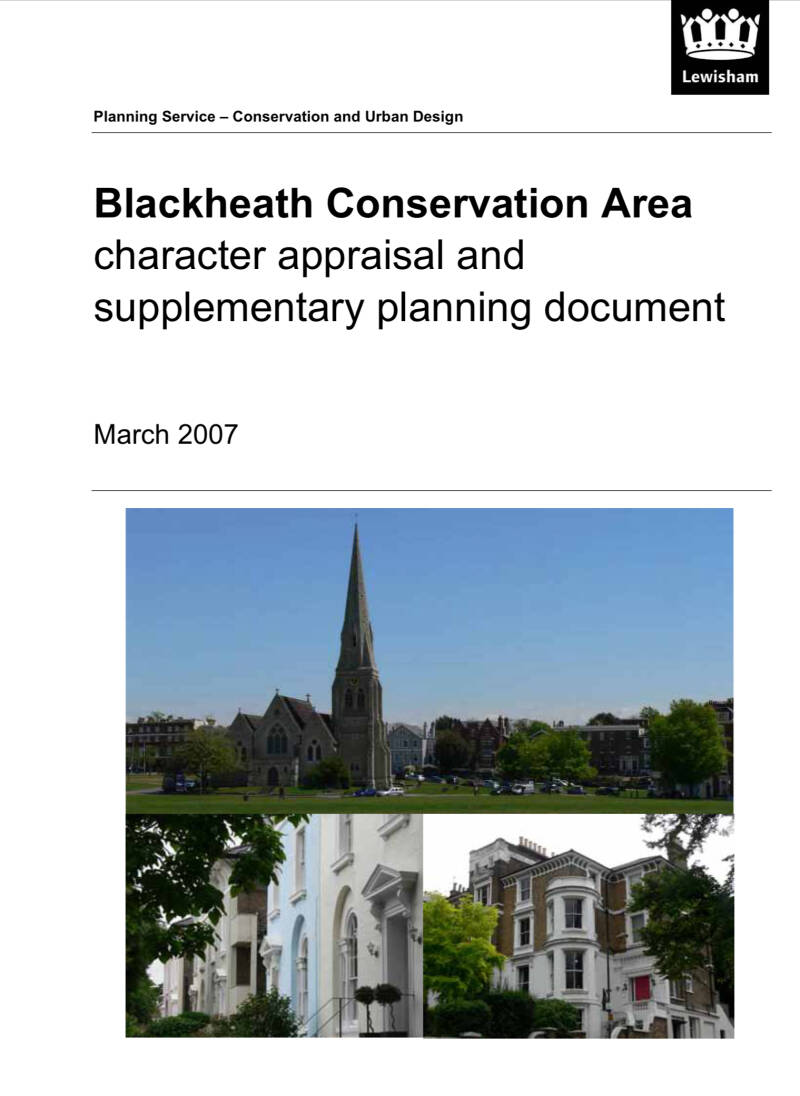


This is a walking/cycling route along Lee Road, Blackheath Village and Tranquil Vale (road) dealing with the sights both sides of the streets , and those important ones along the off roads
Between Lee Road and Lee Park
1) The CHURCH OF JESUS CHRIST OF THE LATTER DAY SAINTS (MORMONS)
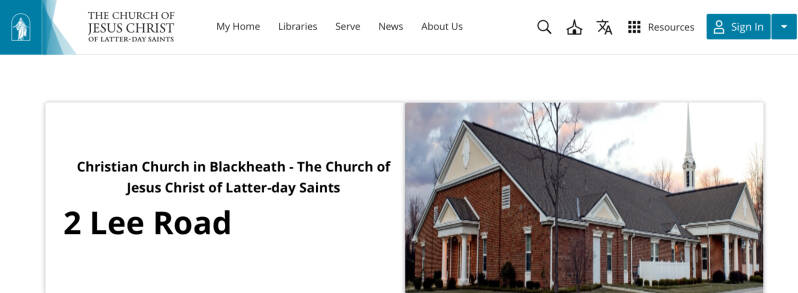
1984. Archs. GARETH WRIGHT and COLIN DIXIE. On the site of the GARDENS of the prominent DOCTOR’S HOUSE (1833, demolits Bed 1970s), the residence the local GP for almost.
Brown metal roof. Boxy brick building.
HISTORY OF THE CHURCH OF JESUS CHRIST: https://www.churchofjesuschrist.org/welcome/our-history?lang=eng
Lee Road
2) BLACKHEATH CONCERT HALLS
Arch’s. JAMES EDMESTON and EDWARD GABRIEL.A product of a remarkable movement led by local philanthropist WILLIAM WEBSTER (1856-1910) to cater for the arts in Victorian B. It opened in 1895, with 2 auditoria: the main hall, originally seating around 1.000 people and, behind those tall windows, a smaller first-floor recital room.
Frieze with musical cherubs and heads of worthy local gentlemen.
In its heyday BCH attracted world famous artists as CLARA BUTT and FRITZ KREISLER. Audiences though declined and by 1939 the directors were content to hand it over for government use. In the 1970s it stood empty and demolition threatened; once again B people rose to the challenge: funds were raised, grants obtained, and a phased restoration began. In 1991 the now 700-seat main hall reopened, marking the project completion.
It is currently owned and managed by TRINITY COLLEGE OF MUSIC, offering a variety of musical and other events.
3) BLACKHEATH CONSERVATOIRE for MUSIC and the ARTS
Again, EDMESTON and GABRIEL were the architects. And this institution was part of the same artistic flowering as the HALLS, opening in 1896 to house the already existing Conservatoire. The separate ART SCHOOL was taken over in 1991. Both, thriving now.
4) Nos. 1-17. Shops and living/working quarters
1882. On the site of earlier houses, BEACONSFIELD BUILDINGS (as this row was known) became almost entirely a department store, HIND’s. The store's story started in Wales with the birth of John Hinds at Caernarvon in 1862. He left school at 14 to become an assistant draper before moving to London in 1881. Six years later he started his own store at Blackheath with a partner and one assistant.
At the corner with CRESSWELL PARK, originally the NATIONAL PROVINCIAL BANK branch, purpose built. NATWEST closed in 1997, after 130 years. Now a restaurant.
MORE ABOUT HINDS: https://www.newsshopper.co.uk/news/6365981.the-eltham-society/
Blackheath Village (road)
5) SELWYN COURT
Typical 1930s block of flats with shops at ground level. In 1936 this seemed an outré style an it was built after the demolition of the BLACKHEATH PROPRIETARY SCHOOL, from whose greatest Headmaster, the Re. JOHN SELWYN, derives the name.
The BPS was founded in 1831 as a fee-paying school for the sons of the middle classes. Amongst its students, many a Nieves distinction in the profession and the armed services. In 1862 a group of old boys f. B’s famous rugby club.
(East) Creswell Park (cul-de-sac)
16 Nos. 1-4
2 país of villas. The second: stucco, 3 storeys plus garrets, and basement. Early 19th c.
17 OUR LADY HELP OF THE CHRUSTIANS R.C. Church (ST.MARY’S)
Arch. ALFRED PURDUE. 1891. Typical Victorian Gothic, with mini-spire
18 PARK HOUSE
Ashlar-faced, grand Doric porch and front door approached up by twin, curving flights of steps. A bit out of place?: THOMAS LARKINS, an East India ompany captain built it in 1787, using the façade of WRIKLEMARSH, B’s grandest house, after been sold off by JOHN CATOR. A good piece of recycling!.
It became an orphanage for RC boys, leading to the building of the church next door. Now, it houses the presbytery and parish offices
(West) Lawn Terrace
6 Nos. 11-17
4 charming little “tea-caddy” cottages. By local builder WILL.SEAGER, on a mere unnamed footpath. No.1 was home to the BLACKHEATH PRESS, a firm of printers, between 1939 and 1959
(West) Independents Road
(7) WINCHESTER HOUSE. Former SCHOOL and HOME for sons of missionaries
WG HABERSHON, arch. 1857. Sternly, upright, Neo-Gothic. For the LONDON MISSIONARY SOCIETY. DAVID LIVINGSTONE’s sons and ERIC LIDDELL (CHARIOTS OF FIRE)… studied/lived here. Now, ELTHAM COLLEGE.
In 1916 Belgian refugees were housed here. Later on, it became flats.
In 1976, the CHURCH ARMY restored it for use as a world HQs.
Now, consulting rooms of the BLACKHEATH HOSPITAL (main building in LEE TERRACE)
8 Former CONGREGATIONAL SCHOOL
Archs. BRANDON & RITCHIE. 1853. It sat a congregation of 1.000. Badly damaged during WW2, restructured in 1957 by arch. TREVOR DANNATT, providing a smaller, simpler church within the shell. Then, 1982, converge to offices, by archs. WATTS & PARTNERS.
9 FRIENDS MEETING HOUSE
1979. Arch. DANNATT. A grey, polygonal concrete box, contains the main meeting hall. Top-lit, austerely tranquil and very Quakerish. Other rooms and facilities and an open-sided undercroft
W 15) Former ALEXANDRA ASSEMBLY ROOM and SWIMMING BATHS, then LLOYD’S BANK
Stucco, 1863. It became a bank in 1928
13 East—Bennet Park (cul-de-sac)
Solid Victorian (dev. from 1869s onwards, reflecting current stylistic fashions) houses, 4-storey paired villas.
14 Former BLACKHEATH ART CLUB, then CLUB FILM UNIT, now flats
Archs. HIGGS and RUDKIN. Arts & Crafty, high gabled, mid-1880s A club and studios for local artists, it was another of W.WEBSTER’s cult.init.
In 1998 B.PRESERVATION TRYST reconverted it into studio flats, keeping the Art Club name
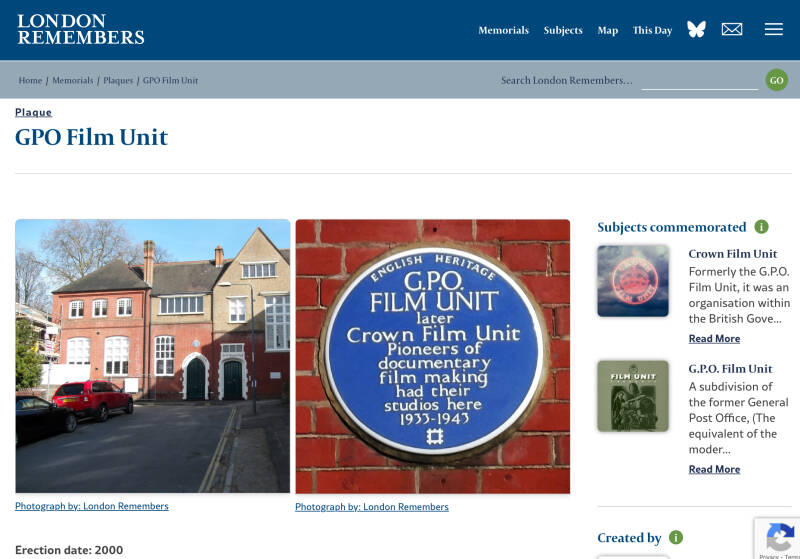
CROWN FILM UNIT. 1933-43. it was an organisation within the British Government's Ministry of Information during World War II. Its remit was to make films for the general public in Britain and abroad. Output included short information and documentary film (NIGHT MAIL) as well as longer drama-documentaries. It continued to produce films, as part of the Central Office of Information (COI), until it was disbanded.
10
E 19 Nos. 3-13 Blackheath Village
Part of a larger 1828 row of houses, with faint allusions to the Regency style. The railway amputated the parade and and the taller and grander buildings date from Victorian times, when demand for shops grew. Single storey front extensions added over the diminutive front gardens.
LESLIE BILSBY the developer of many admirable SPAN ? estates off nearby BLACKHEATH PARK regarded this group as of no value and had grand plans for a modern block, but Blackheath people stopped any redevelopment.
REMINISCENCE CENTRE: AGE EXHANGE
An innovative local organisation which works to involve older people in recalling and celebrating the times they lived through.
(11) BLACKHEATH railway station
Parts of the the building date from 1849, that is parts of the only original station building on the NORTH KENT LINE, between LONDON BRIDGE STA. and DARTFORD, and still in operational use. The rest, stucco-faced dates from the 170870s..
E (12) Former STATION ASTERS’S HOUSE, now CHAPMAN HOUSE
A hidden gem from 1849, along them”up”platform was restored by the B PRESERVATION TRUST, in 1983, providing offices for several organisations, including the B.SOCIETY.
ED.DUNCAN CHAPMAN was stationmaster a prodigious 48 years!.
2025 UK RAILWAYS ANNIVERSARY

The LONDON & CHATHAM RAILWAY developed the line, which follows the valley of what was the KID BROOK, from 1845 onwards. It had a minimal impact on B’s environment, because it is largely hidden in cuttings and tunnels. The engineer in charge was G R STEPHENSON, a local man, living in BLACKHEATH PARK, but nephew of the illustrious railway engineer GEIRGE STEPHENSON.
The opening of the railway set off a spate of development which turned B from a hamlet to a prosperous middle class suburb.
E (20) Future LIBRARY SQUARE?
23 MARTIN HOUSE
(24) Nos.3-9. At No. 3, MADELEINE’s CREPERIE

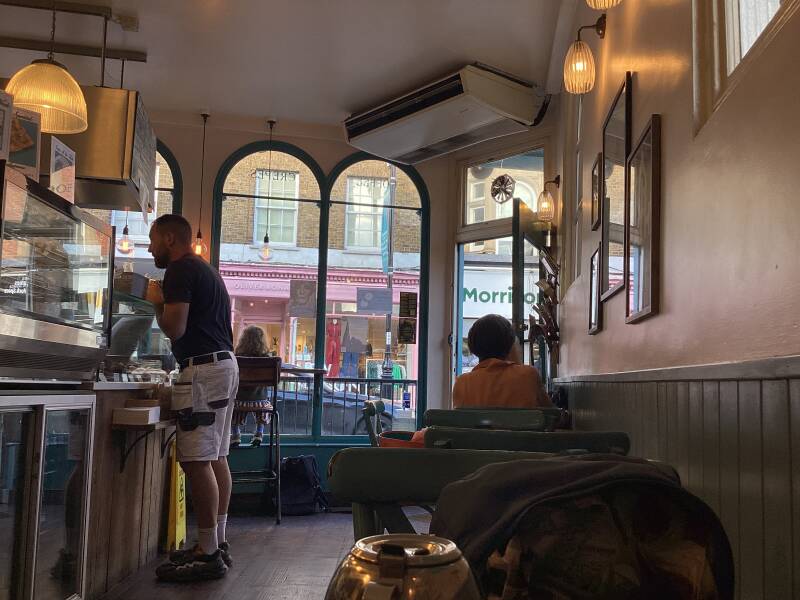

Shops and eateries (built as shops) b.1845, but with Georgian proportions.”SPENCER PLACE” was the original name of this parade (see plaque). No.3 was originally a grocery. The whole group, restored after bomb damage.
The open entry of the GF of no.11 looks what may have been stables.
Blackheath Grove (road)
Before the railways this was a place of market gardens, with a swimming pool fed by the KID BROOK.
(E) 21 BARKLAYS BANK
Arch. EH BOUCHIER. Erected by the bank’s predecessor, the LONDON & PROVINCIAL, in 1888. But here, in a previous building if 1861, a the NORTH KENT BANK had the first B bank branch.
Lofty building with a shelf canopy above its corner entrance. Tall chimney stacks above mansard roof
EAST (22) POST OFFICE
Solid, neo-Georgian
K2/K6 phone bixes
Here the street becomes TRANQUIL VALE
A considerable misnomer given the traffic that goes through
West (25) Nos.11-17
Little row of shops b. 1820s but wit parts of their fabric still older: weatherboarding on the back elevations, signs of timber frame construction… It may constitute the oldest occupied site in B. In fact, the KIM FAMILY occupied a cottage (now, nos .11-13) in the mid 18th c. No13 was a fishmonger from 1820 to 1998.
Two more 2-storey premises are set back from the road.
West (26) Nos.19-21
Large single sash windows above shops. A workshop and a stable, in the mid 19th c.
East (27) Nos.18-20
1903. Brick and stone for vertical features, vestigial balconies, odd pediment-like protrusions and pinnacles. Offices upstairs, central entrance, two shops flanking it.
No.20 Until the 1980s a book-store, owned by the BURNSIDES.
East (28) Nos,22-34a Tranquil Vale & 2-10 Montpelier Vale
Long 3 storey terrace, yellow stock brick, sash windows, b.1839 (on the site of an 18th c. single house and garden) owned by market gardener EDWARD SADLER, who also bred carp in the nearby stream and pond), still to a Georgian proportions, curving alongside the triangle into Montpelier Vale.
A useful addition to the commer heart of B VILLAGE, catering to that early Victorian expansion. Shopkeepers lived “above shop”.
No.30 has been a pharmacy since 1840..
West (30) Nos.23-27

1797-8, originally as houses by local developer JOHN COLLINS. But more and more shops were needed: Victorian middle classes were voracious shoppers, prosperous Blackheath wives descending from their carriages to be met by respectful tradesmen.
Look at nos 25-27: it was an originally a markedly superior residence. A distinctly grand front door between the 2 sets of shop windows. 6 tall Georgian windows on each floor (surrounds now picked up in deep red).
No.23. White wooden railings, down to a door below pavement level (the lands falls away under these buildings so that what is basement at the front is ground floor at the back)
Parés Footwear was an independent children's footwear retailer in Blackheath, London, which operated from Tranquil Vale at numbers 25-27, serving the community for over a decade before closing in November 2023. The shop was a family-run business, established in 1985 by Mr Mehmet Salih Bayramoglu, and provided a walk-in shoe fitting service.
East (29) No.38 Tranquil Vale, corner building, between the 2 Vales
3 storeys. Above the door 2 storeys with narrow bow windows.Topped by a curious squat grey cone, looking more like a candle snuffed than a spire!.
Now offices above shops.
This is part of a 1880s development of shops which stretches left up tranquil Vale and right up Montpelier Vale.
Until the early 18th c. the HEATH came right down into the well of the village.
A row of 1820s shops were replaced by nos 38-48. Shopping!.
Nos, 31-35 are of a different style. Mansarda roofs and dormers. A graceful curving parallel linking the door to 31a. The pavement here has been replaced with York stone, right up to the fronts, with a row of metal studs marking the boundary with the private forecourt. For more than a century a pharmacy with photographic dealers (BUTCHER CORNOW).
West (31) Collins St.
Development built to accommodate the growing population of railway workers, skilled artisans, shop workers… attracted to the developing suburb
West (32) Nos. 37-43 Tranquil Vale
Broad stuccoed corniced 1860s buildings, hiding pitched roofs.
No.37, 1869, Alfred Gilbert arch., looks imposing, as its original occupants intended: LONDON & COUNTY BANKING CO. However, a wedge shaped building, there is rather less of it than it appears.
No.39, black make-over, pavement-to-roofline. Hideously painted, no matter that this building is in a Conservation Area
West (33) Collins Square
Group of picturesque, black weatherboarded cottages, with pantile roofs. Built 1798. The BLACKHEATH SOCIETY saved them from demolition, in the 60s. NEIL MACFADYEN (of Archs. CARDEN & GODFREY) has restaured and enlarged them
East (36) No.52. Former THE THREE TUNS P.H., no O’NEILLL’S
1885, although a pub has been here since the 1720s. On a site granted by the EARL OF DARTMOUTH, that was back then open heath
West (34) Nos.45-47
Same vintage as the cottages. Single, generous, sash windows. No. 47, Weatherboarding and pantile roofs. Well preserved shop front.

Short (walking) detour
East (37) Tranquil Passage
Exploring it you get the impression of the scale of the expanding village before the late Victorian development. The area was first built over from the early 1800s, becoming byword for slums, with shoddy, crumbling fabric, leaking privies, contaminated water supply. From the 1860s onwards the area was redeveloped.
(38) Former ALL SAINTS SCHOOL, TRANQUIL HALL
1851.It has served in turn as school, public library, recording studio, once again, a school… now a community hall.
It was left to the B SOCIETY by one of his founders, ROGER MARTIN, providing income for the society to employ a secretary and have its office in CHAPMAN HOUST (12).
Royal Parade Mews
(49) Brigade Street
It does a dog-leg. Modest, little streets showing the shape and style of pleasantly backward-looking development of the early 1870s village hinterland
(48) Former FIRE STATION, now BRIGADE HOUSE, residential
1871. The METROPOLITAN FIRE BRIGADE was established in 1865. Local people had early awareness that it took too long for horse-drawn fireengines to come from Lewisham or Greenwich… The Earl of Dartmouth provided the land at the low rent of £15 a year. In 1909 it ceased to be a fire station, being converted into commercial use, for much of the time for photographic processing. Now, apartments. Doorway modified.
Royal Parade
SHOPS and EATERIES
(40) Nos.70-74 Tranquil Vale
Part of the HIGHLAND HOUSE development, 1879. At the time, the last word in modernity, later on, object of derision. Gables
Bookshop
(39) Nos.58-68 Tranquil Vale
Houses with garrets in the mansard roofs (slated and pan tiled), built around 1800. The present shops were built over the front gardens.

Back on route, Northwards, along Tranquil Vale
West (35) THE CROWN P.H.

A pub has existed on this site at least since the 1750s. The current building is contemporary with the cottages, but it looks as though it was re-fronted in the 1880s. Dormers in a mansard roof.
West (42) South Vale Road
1870s. Built for artisans and shopkeepers, separated from the rather more prosperous middle class they served. Nowadays, occupied by well-heeled professionals and their families
West (41) MARY EVANS PICTURE LIBRARY
Two local residents, MARY and HILARY EVAND , in the basement of their house, started in 1989 what grown into a nationally known institution, which supplied HISTORIC PICTURES to the media.
The building is an inter-war ARTS & CARFTSY one, an example of “domestic revival”, with a patterned gable, designed by CC WINMILL, an arch. who belonged to the LCC team of architects. Until the 1980s it was ALL SAINTS Church HALL.
QUEEN VICTORIA’s DIAMOND JUBILEE FOUNTAIN

West (43) Camden Row
1890s typical Artisan cottages
West (44) Nos.63-65
Tall early 19th c. Stock brick, with a beautiful curving turning the corner.the shop front was skilfully inserted at a later time.
(45) Nos.67-69
Two spacious and well put together dwellings of 1889 and 1890
Eastnor Studio, Eastnor Garden House, Eastnor Cottage
West (46) EASTNOR PLACE
Stuccoed main front round the corner in Lloyds
47 ALL SAINTS Church

Benjamin FERREY, arch. 1857. Kentish ragstone. Asymmetrically placed spire, on the open heath. It works superbly in townscape terms, as it has UCL more impact that it would have had if it had been in the body of the village. It helps enclose a slave which may be though as a village Green.
From WOLFE’S STATUE in GREENWICH PARK, along the AVENUE to the HEATH, serves as a main stop to the main vista. It is unlikely that this consideration was in the mind of the EARL OF DARTMOUTH when he gave to the Burch authorities a space on the B WASTE.
Grote’s Buildings
Andrew Grote, a developer and banker who built Grote's Buildings (also known as Grotes Buildings) in the 1760s on land leased from Morden College.
ORIGINAL HQ. OF MASS OBSERVATION
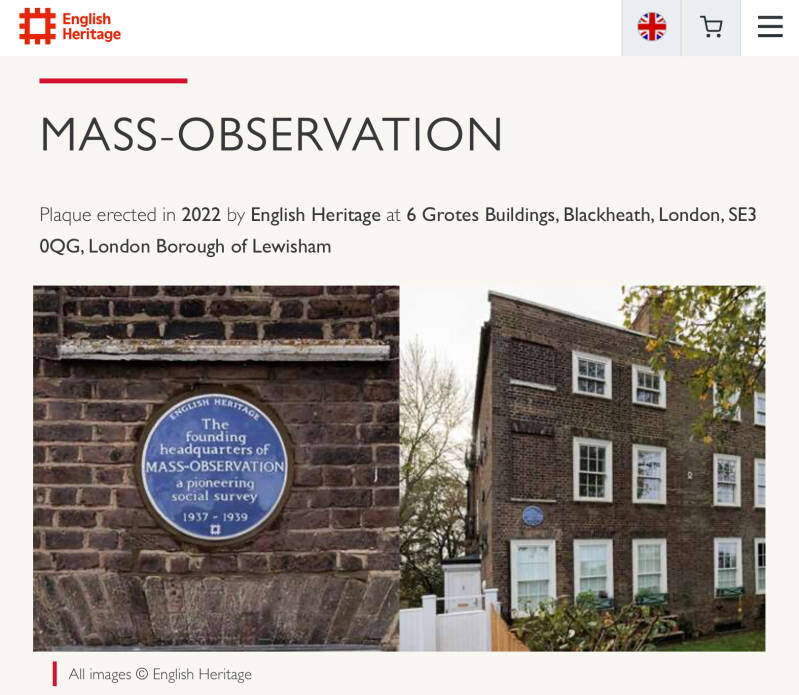
English Heritage has marked with a blue plaque the original headquarters of Mass-Observation. The large detached house, on the edge of Blackheath village in SE London, was the home of Mass-Obs co-founder, Charles Madge (1912-1996), and served as its national office for two years from its inception in 1937. Madge himself was a poet and a journalist for the Daily Mirror.
The Mass-Observation website relates the story of how the organisation was founded to collect data on social attitudes and create an ‘anthropology of ourselves’. These data are now archived as part of the University of Sussex’s Special Collections.
Eliott Place
HEATHFIELD HOUSE
Mid-late C18 house with front of early Cl9 appearance. 3-storey,
3 window centre block with 2-storey, 1 window, slightly projecting
side wings with ground floor bowed out. Balustraded balconies over
bows, linked by centre balcony resting on portico distyle in antis with
square columns. Stucco with cornice and blocking course, and moulded
architrave in centre. Plain reveals to sash windows with glazing bars,
some replaced. Console bracketed cornices over lst floor windows, and
over ground floor windows in bays, which are 3-light and curved. Modern,
glazed double door in moulded architrave.
THE HARE AND BILLET P.H.

Watling Street, the Roman road to Dover, crossed the bleak and forbidding Blackheath and, in the 18th century, this stretch of the busy route was notorious for its highwaymen. At this time, the Hare and Billet was an isolated coaching inn on the heath.[3] The establishment has been trading since the 1600s.
On 20 January 2014, the pub was mentioned by Jim Dowd, MP for Lewisham West and Penge, during a debate in the House of Commons on the Intellectual Property Bill. The Hare and Billet was where Dowd was served Henderson's Relish when he asked for some Worcester Sauceduring a meal. As Dowd was unfamiliar with Henderson's Relish he later cited the product as an example of "parasitic copying", namely of the anchovy-based condiment sold under the Lea & Perrins name.[7] Due to the cult following enjoyed by Henderson's in Sheffield and South Yorkshire, Dowd faced a backlash in the media, which included an open letter rebuttal from the Deputy Prime Minister Nick Clegg[8] and Dowd's Labour Party colleague Paul Blomfield, MP for Sheffield Central.[9] The pub noted that a number of Sheffieldersliving in London had visited the pub as a result of the media coverage that was generated
Pond

Bus route

Goffers Road
An old name for golfers!!!

Hare and Billet Road
Elliot Cottages
Elliot Place
Eliot Place, a row of detached and semi-detached houses on the edge of the Heath, was built between 1795 and 1802. It survives intact except for No. 9, which was rebuilt in 1911. Benjamin Disraeli went to school there and a blue plaque records the residence of Sir James Clark Ross, the polar explorer, at No.2. The part of the Heath opposite became a semi-private playing field for the boarding schools in Eliot Place.
A J. Ripper connection… with Benjamin Disraeli
To supplement his income and help pay for his legal training, Druitt worked as an assistant schoolmaster at George Valentine's boarding school, 9 Eliot Place, Blackheath, London, from 1880.[30] The school had a long and distinguished history; Benjamin Disraeli had been a pupil there in the 1810s, and boys from the school had been playmates of a younger son of Queen Victoria, Prince Arthur, Duke of Connaught, who as a boy in the 1860s had lived nearby at Greenwich Park.[31] Druitt's post came with accommodation in Eliot Place, and the long school holidays gave him time to study the law and to pursue his interest in cricket
SIR JAMES CLARK ROSS
Orchard Rd. (and Drive)
The Orchard and the north side of Eliot Vale loosely represent the Arts and Crafts period; with the use of prominent gables, timber.
The Orchard (road)
Pagoda Gardens
A suffragette attack took place here
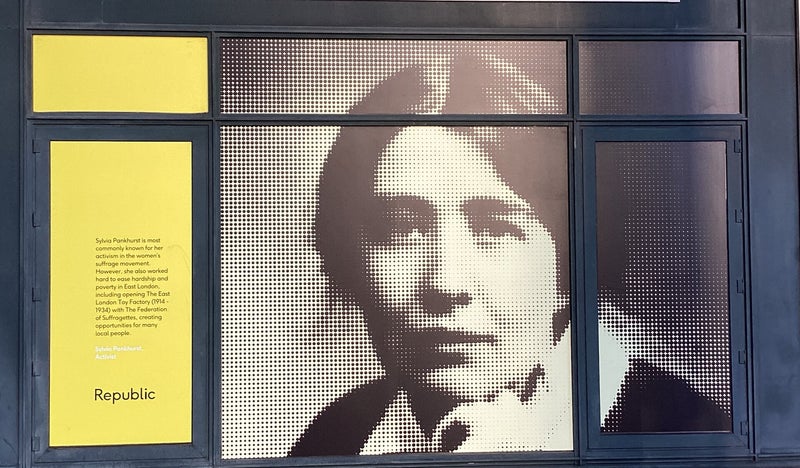
THE PAGODA
The Pagoda was built in 1760 as a summer house for the Earl of Cardigan and was later used by Caroline, Princess of Wales.
It was enlarged in the mid 19th century and became a London County Council children's home a century later. It is now a private house again.
Its extensive grounds were built on in the 1860s. Though architecturally unusual, its history is similar to other large houses nearby, such as the Knoll.
This house was formerly a pavilion attached to Montagu House. It was built in 1770-80 for the 3rd Duke and Duchess of Buccleuch. It is an exceptionally rare example of a style known as Chinoiserie (based on all things Chinese). It was probably designed by Sir William Chambers. Caroline of Brunswick lived here after her separation from the Prince Regent in 1799. Montagu House was demolished in 1815. The Pagoda was extended in the 1820s for the Legge family and in the 1850s for Lewis Glenton.
Nearby, Granville Park
SAMUEL SMILES lived here
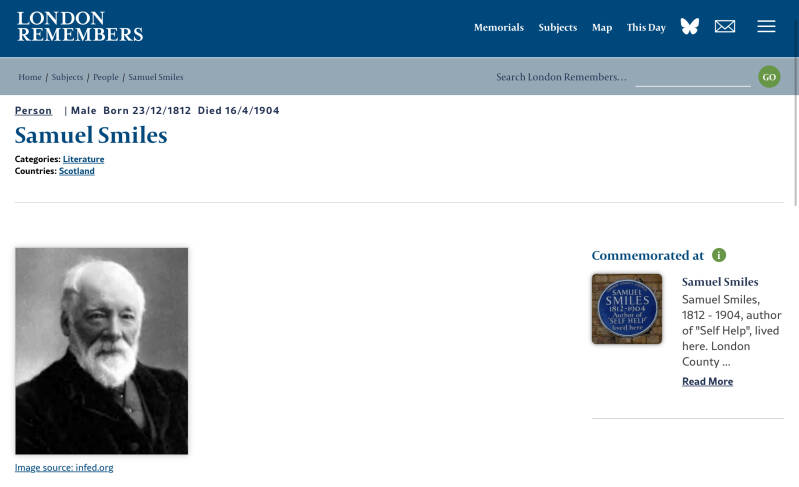
Author and chartist supporter. Born Haddington, East Lothian, Scotland. He studied medicine before becoming a newspaper editor. Best known for his work 'Self-Help' which promoted thrift, and claimed that poverty was caused largely by irresponsible habits. Died at 8 Pembroke Gardens, Kensington.
What’s in a name: Granville, Eliot, St Germans
Around Lewisham there are a few names that recur frequently. One that we see a lot at the Blackheath end of the High Street is Granville,
Aberdeen Terrace
GEORGIAN HOUSES: https://www.kershaws.online/property/aberdeen-terrace-blackheath/
Mounts Pond Road
Blackheath, manorial waste
Manorial waste refers to land within a manor that was uncultivated, unproductive, or held in common by the lord and tenants. It was often poor quality land, including areas like hedges, verges, or other open spaces. While owned by the lord of the manor, tenants and villagers typically had rights to use manorial waste for purposes like grazing their animals or gathering resources, such as peat and firewood
Wat Tyler Road
In both the Peasants' Revolt of 1381 and Jack Cade's rebellion of 1450, the rebels camped on the Heath (a convenient high point overlooking London). The Cornish rebellion of 1497 was defeated in a battle on Blackheath.
Wat Tyler (1341 or c. 1320 – 15 June 1381) was a leader of the 1381 Peasants' Revolt in England. He led a group of rebels from Canterbury to London to oppose the collection of a poll tax and to demand economic and social reforms. While the brief rebellion enjoyed early success, Tyler was killed by officers loyal to King Richard II during negotiations at Smithfield, .
Site of MANOR HOUSE. Now Army Cadet Training Centre & housing
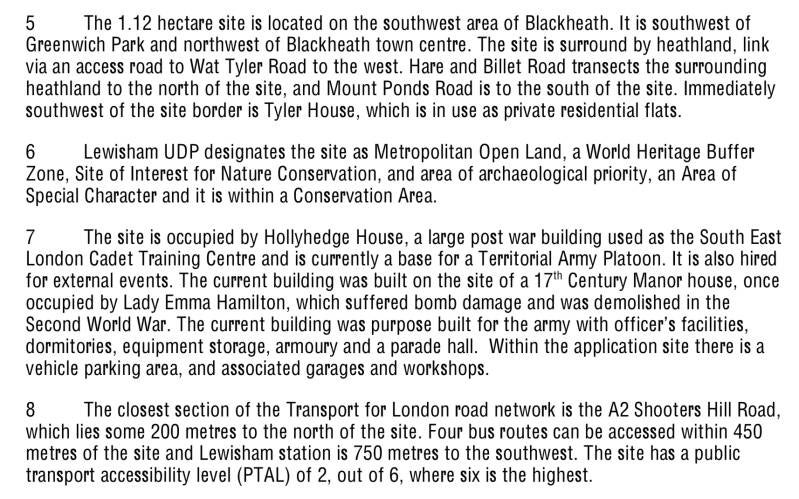
GEORGE ROMNEY portrait of LADY HAMILTON takes you to HAMSTEAD: https://alondoninheritance.com/tag/lady-emma-hamilton/
The former DARTMOUTH ESTATE. The Earls of Dartmouth
The family seat is Blakelea House, near Marsden, West Yorkshire, though there was also a family home at Sandwell Hall (since demolished) in the Sandwell Valleyin West Bromwich, and Patshull Hall, near Pattingham, Staffordshire. The district of Dartmouth Park in north London also belonged to the family, and the family also owned land in Lewisham in south London, hence the subsidiary title Viscount Lewisham.
https://british-royal-family-encyclopedia.fandom.com/wiki/Hon._Rupert_Legge THE CURRENT HOLDER
PRINCESS DIANA’S STEP MOTHER https://british-royal-family-encyclopedia.fandom.com/wiki/Raine_Spencer,_Countess_Spencer
THE EARL OF DARTMOUTH RESIDENCE: GREYLADIES GARDENS
The College of the Greyladies (or Greyladies' College) was an institution established in the late 19th or early 20th century to train women as pastoral workers for the Church of England. These women, often working in isolated communities,
Elsie Baker was one of the women who trained at the Greyladies College for Women Workers in Dartmouth Row. The College was for women who acted as pastoral workers in South London, a kind of early unpaid social work.
The Church of the Ascension was the first parish church to formally ask for a member of the church to be ordained priest. Deaconess Elsie Baker’s name was put forward by the Church after a debate at the Annual Meeting in 1975. Rev. Elsie was one of the first women ordained to the priesthood in the Church of England, and though she was too old to lead her own parish, her contribution to this parish and to the wider church is inestimable.
Dartmouth Hill, Dartmouth Grove,Dartmouth Row
historic luxury housing area in Blackheath, London, centered around Dartmouth Row and Dartmouth Hill, which was developed in the late 17th century by Lord Dartmouth on land formerly owned by his family's manor. The estate includes grand villas and period properties, with Dartmouth Terrace also known for its striking Victorian architecture.
Dartmouth Row is a historic street in Blackheath, London, characterized by its Grade II listed Georgian and Queen Anne architecture, including notable properties built around the late 17th and early 18th centuries, which reflect a rich architectural heritage and a connection to the historic manor of Lewisham and the Earl of Dartmouth. The area, set near Greenwich Park, showcases prominent period homes, often with significant gardens, and was once the site of Dartmouth House, a historic residence of the Earl of Dartmouth
Church of the ASCENSION
Our historic building dates from 1697, though it was largely demolished and rebuilt in 1834.
It is Grade II* listed, a fine example of Georgian architecture in the conservation area of Blackheath, and is unusually listed not just in its own right but as part of a group of three fine buildings on Dartmouth Row. Damaged by bombs in World War II, the interior was extensively remodelled in 1953. We have a new reordering project underway which will redecorate and upgrade the interior, while being sensitive to the value of this historic building.
The Vicar is happy to show people around the building by prior arrangement (contact us), or drop in on a Sunday at 11:30am for the end of our worship (you'll get a free cup of tea then!)
JAMES GLEISHER, astronomer and meteorologist, lived here
James Glaisher lived for over 30 years at 20 Dartmouth Hill. Glaisher (1809-1903) was a pioneer in weather forecasting and aeronautics, and his former home is marked with a Blue Plaque. He was the Superintendent of the Department of Meteorology and Magnetism at the Royal Observatory,
Glaisher established the first UK climatological observing network and is considered a pioneer of weather forecasting. He also invented the Glaisher Screen for thermometers.
Shooters Hill, A2 road
North Blackheath

Bus routes 53 and 386
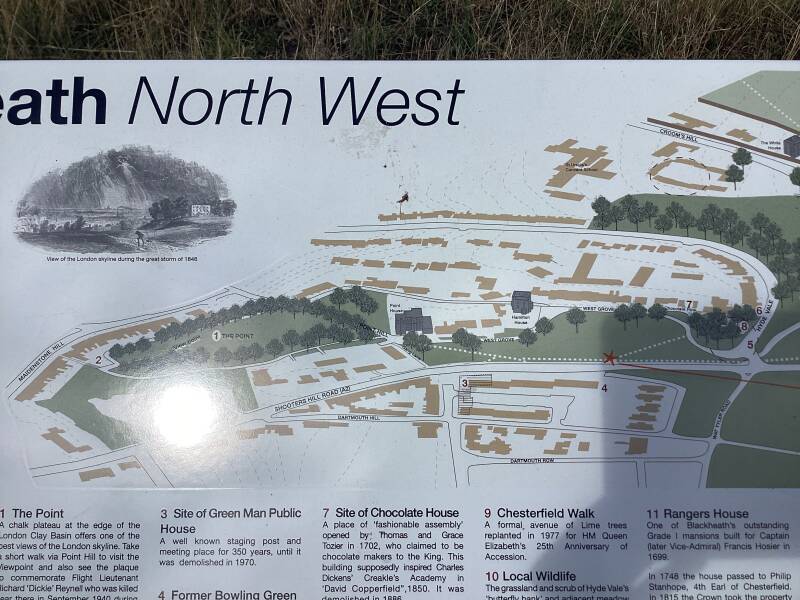
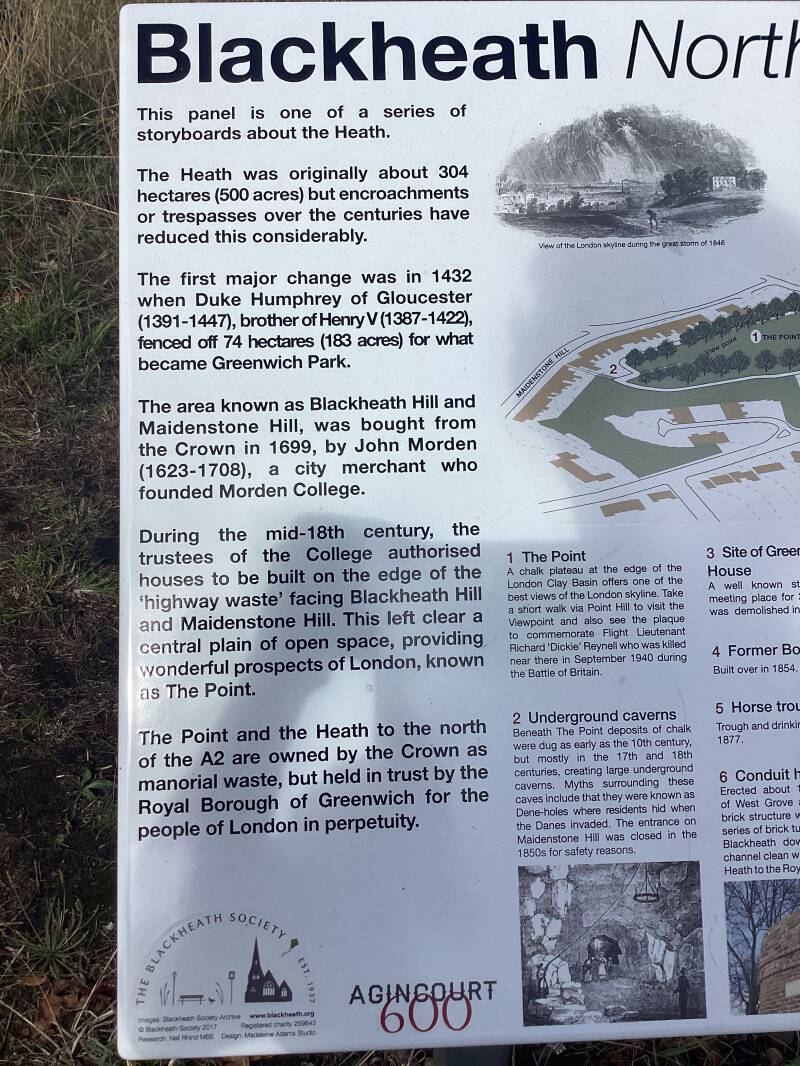


WEST GREENWICH Conservation Area
West Grove
Numbers 2 -13 The Grove (later West Grove), c.1905.
This part of Blackheath was known originally as Chocolate Row and later as The Grove. The first name came from the (drinking) chocolate house built here in 1702, which became one of the centres of social life in 18th century Blackheath.
Most of the 18th century houses in this part of West Grove have perished.
Built in the early 19th century, No.2 (on the right) has been restored following war damage.
Dickens' Creakle Academy (David Copperfield) was set on Blackheath, probably in West Grove.
https://ideal-homes.gre.ac.uk/lewisham/assets/galleries/blackheath/west-grove.html
POINT HOUSE
A famous CHOCOLATE HOUSE, in Blackheath?
West Grove was popular at the beginning of the 18h century for no.6 was flourishing as a place in which to drink the newly fashionable beverage of chocolate. Grace Tossier, the proprietor, enjoyed the title: "His Majesty's Chocolate Maker'. The local which played host to the movers and shakers of the 18th century when the town was a hub for astronomy, science and culture.
Chocolate houses in London
Chocolate was developed by the Mayans in the Central American rainforests who called it cacoaor ‘food of the gods’. The Spanish learnt about it in the early 16th century from the Aztecs to the north who prized it more highly than gold and used the beans as monetary currency, calling it xocolatl. The secret remained with the Spanish for another hundred years until it was mixed with vanilla and sugar, becoming a fashionable drink at the French royal court. The first record of a chocolate drink being sold in London was in 1657 at a shop called The Coffee Mill & Tobacco Roll and around that time cocoa powder also began to be used as an ingredient for making cakes. A heavy import duty was soon imposed, however, and its cost became prohibitive to all except the wealthiest.
What about coffee, tea and beer? https://www.thehistoryoflondon.co.uk/coffee-houses/
GROVE (HAMILTON?) HOUSE. Enderbys and Twinnings dwellers…

Built between 1734 and 1740. The land was purchased from a yeoman John Hatch who farmed and owned a few small holdings. He had to pay a fine to the local parish for encroaching onto the common land which is now Blackheath.
The house was built by Peter Bronsden, a famous shipbuilder from Deptford, whose monument is in St. Nicholas Churchyard. The Bronsden family was in partnership with the Wells, and both were considered respectable country families.
The influential Enderby family acquired the building in 1778 and Samuel Enderby lived here until 1797 They owned a whole fleet of ships. When at The Boston party tea was thrown into Boston Harbour as an act of defiance towards the English colonial rulers. It was the Enderby's who owned these ships. Their ships were also used to transport convicts to Australia and we presume the dungeon in the basement with its steel door was originally used as overnight accommodation. The Enderby's are usually remembered for their involvement in the whaling Industry and in Moby Dick Herman Melville writes "all honour to the Enderbys".
Between 1844 and 1850 Richard Twinning of Twinning's tea fame lived here. One of the wooden floors, which is still to be restored, was made from cases used to transport tea.
In 1851 the house was purchased by a family who was to stay for the next 60 years: the Knills. Sir Stuart Knill (1824-1898) and his son Sir John (1856-1934) who were both to become Lord Mayor of London in their time.
During the Second World War the railings were used for armaments and the house lapsed into disrepair. Recently a large amount of time, money and love has restored the building to its original elegance.
Westgrove Lane
THE POINT
Point Hill
Royal Hill
Gloucester Circus
Former GREENWICH TOWN HALL
PUBLIC LIBRARY (“The gift of Andrew Carnegie”]
South St.
Birthplace of ALFRED SALTER
QUEEN ELIZABETH COLLEGE
GREENWICH STATION
DAVY’s

Bus routes along GREENWICH HIGH ROAD

Alternative route, from SHOOTERS HILL, down along Cade Road and Crooms Hill to ROYAL MARITIME MUSEUM

Cade
Jack Cade's Rebellion or Cade's Rebellion was a popular revolt in 1450 against the government of England, which took place in the south-east of the country between the months of April and July. It stemmed from local grievances regarding the corruption, maladministrationand abuse of power of the king's closest advisors and local officials, as well as recent military losses in France during the Hundred Years' War. Leading an army of men from south-eastern England, the rebellion's leader Jack Cade marched on London in order to force the government to reform the administrationand remove from power the "traitors" deemed responsible for bad governance.



